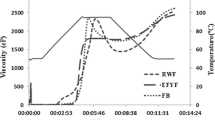Abstract
The present investigation was undertaken on the utilization of alternate flours/meals (rice (Oryza sativa), maize (Zea mays), sorghum (Sorghum vulgare) and pearl millet (Pennisetum glaucum) for the preparation of gluten free cookies as compared to conventional wheat (Triticum aestivum) flour cookies. The physicochemical parameters, sensory qualities and functional properties of flours/cookies were studied and compared with control cookies. The blend of maize and pearl millet had best pasting qualities followed by blend of pearl millet and sorghum flour. The control cookies showed a higher yield (186.8%) but stronger peak force (2.69 kg). The cookies prepared from rice and maize combination had highest spread ratio whereas, the lowest spread ratio was observed in rice and sorghum combination. The cookies with pearl millet and sorghum flour combination had higher fat, protein, ash and calorific values as compared to control cookies. The maximum sensory overall acceptability scores were found for cookies prepared from combination of pearl millet and sorghum flour followed by rice and sorghum, maize and sorghum, rice and maize, maize and pearl millet, rice and pearl millet and control cookies. All gluten free cookies had higher nutritional value as compared to control cookies and were acceptable by panelists.
Similar content being viewed by others
References
Akapapunam MA, Darbe JW (1994) Chemical composition and functional properties of blends of maize and bambara groundnut. J Plant Foods Hum Nutr 46(2):147–155
AOAC (1990) Official methods of analysis, 15th edn. Association of Official Analytical Chemists, Washington
Badi SM, Hoseney RC (1975) Use of sorghum and pearl millet flours in cookies. Cereal Chem 53:733–738
Batey IL, Curtin BM, Moore SA (1997) Optimization of rapid–visco snalyzer test conditions for predicting Asian noodle quality. Cereal Chem 74:497–501
Ciacci C, Maiuri L, Caporasob N, Buccia C, Giudiced LD, Massardod DR, Pontierid P, Fonzoe ND, Scott RB, Ioergerf B, Londei M (2007) Celiac disease: in vitro and in vivo safety and palatability of wheat-free sorghum food products. Clin Nutr 26:799–805
Farrell RJ, Kelly CP (2002) Celiac sprue. New Engl J Med 346(3):180–188
Fasano A, Catassi C (2001) Current approaches to diagnosis and treatment of celiac disease: an evolving spectrum. Gastroenterol 120:636–651
Gupta HO, Singh NN (2005) Preparation of wheat and quality protein maize based biscuits and their storage protein quality and sensory evaluation. J Food Sci Tech 42:43–46
Hooda S, Jood S (2005) Organoleptic and nutritional evaluation of wheat biscuits supplemented with untreated and treated fenugreek flour. Food Chem 90(3):427–435
Lovis LJ (2003) Alternatives to wheat flour in baked goods. Cereal Foods World 48:61–63
Lyne K, Singh AK (1997) Functional properties of wheat and chickpea composite flours. Food Aust 49:1–7
Morad MM, Doherty CA, Rooney LW (1984) Effect of sorghum variety on baking properties of U.S. Conventional Bread, Egyptian Pita “Balady” Bread and Cookies. J Cereal Sci 49:1070–1074
Murry JA (1999) The widening spectrum of celiac disease. Am J Clin Nutr 69:354–365
Patel MM, Rao VG (1996) Influence of untreated, heat-treated and germinated black gram flours on biscuits making quality of wheat flour. J Food Sci Tech 33:53–56
Ragaee S, El-Sayed M, Abdel-Aal (2006) Pasting properties of starch and protein in selected cereals and quality of their food products. Food Chem 45:9–18
Rajput LP, Rao PH, Shurpalekar SR (1988) Use of unconventional protein sources in high protein biscuits. J Food Sci Tech 25:31–34
Rodrigues FSM, Luparelli PC, Schieferdecker ME, Vilela RM (2009) Gluten-free cookies prepared with sorghum flour. Arch Latinoam Nutr 59:433–440
Rosario RRD, Flores DM (1981) Functional properties of flour types of milling bean flour. J Food Sci Agr 32:175–178
Semwat AD, Narsimhamurty MC, Arya SS (1996) Composition of some commercially available biscuits. J Food Sci Tech 33:112–115
Snedecor GN, Cochran WG (1968) Statistical methods, 6th edn. Oxford and IBH Publishing Co, New Delhi
Author information
Authors and Affiliations
Corresponding author
Rights and permissions
About this article
Cite this article
Rai, S., Kaur, A. & Singh, B. Quality characteristics of gluten free cookies prepared from different flour combinations. J Food Sci Technol 51, 785–789 (2014). https://doi.org/10.1007/s13197-011-0547-1
Revised:
Accepted:
Published:
Issue Date:
DOI: https://doi.org/10.1007/s13197-011-0547-1



